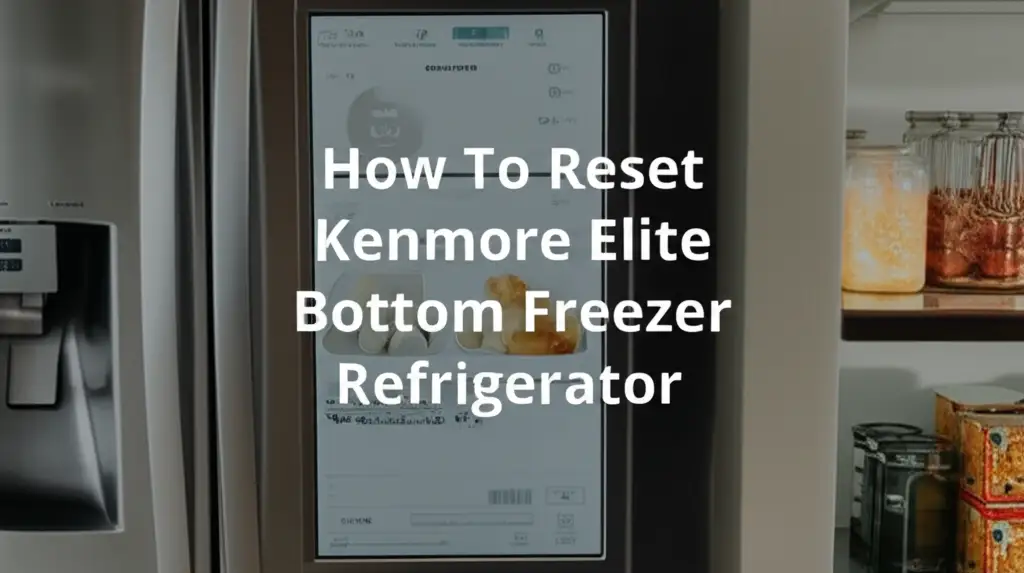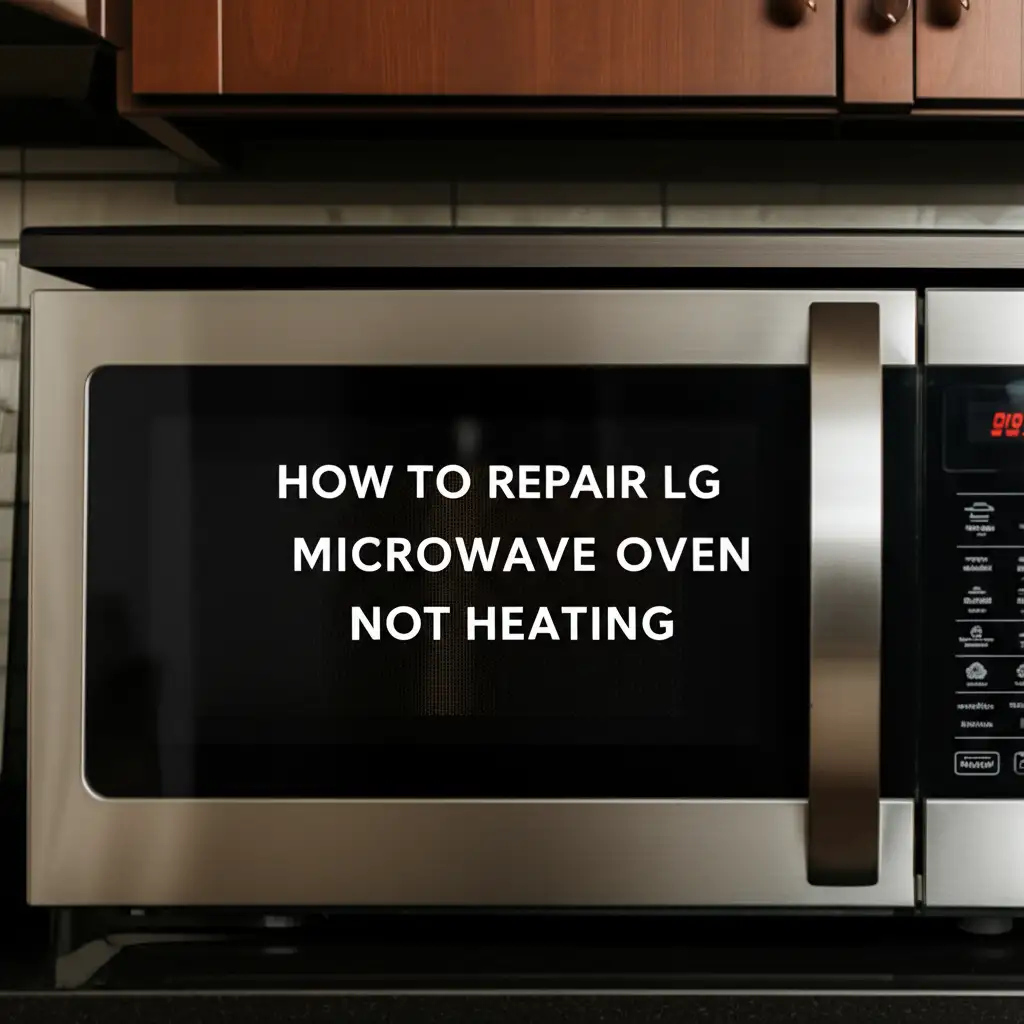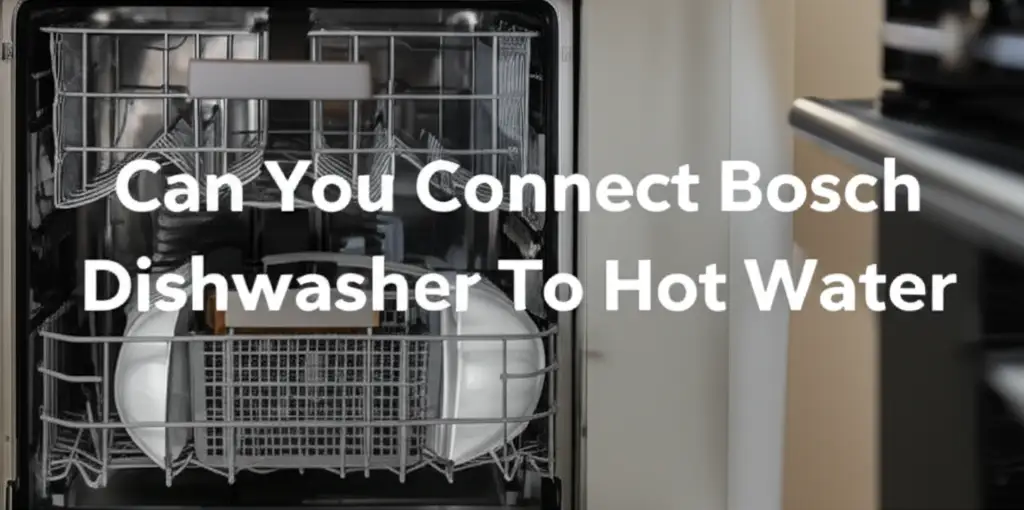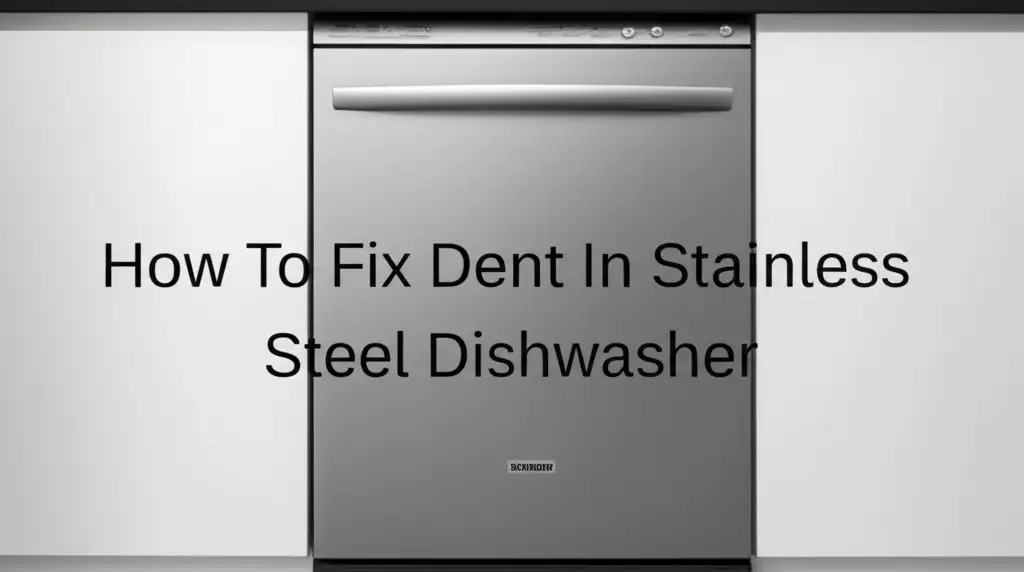· Todd Martin · Home Appliances · 20 min read
How To Reset Kenmore Elite Bottom Freezer Refrigerator

How To Reset Your Kenmore Elite Bottom Freezer Refrigerator
Do you own a Kenmore Elite bottom freezer refrigerator? Sometimes, these appliances encounter glitches. A simple reset often fixes many issues, saving you a service call. You might experience temperature problems, display errors, or a persistent water filter light. Resetting your refrigerator can restore normal operation and clear minor electronic hiccups. This guide helps you understand when and how to perform different types of resets. We will cover everything from basic power cycling to specific control panel resets. I aim to provide clear instructions so you can confidently troubleshoot your appliance.
Takeaway
- Power Cycle: Disconnect power for 5-10 minutes, then restore. This fixes most electronic glitches.
- Control Panel Reset: Follow model-specific button combinations for display errors.
- Water Filter Light Reset: Press and hold the “Filter Reset” button until the light turns off.
- Post-Power Outage: Perform a power cycle after a power interruption.
- Troubleshooting Cooling: Consider resetting if your refrigerator or freezer is not cooling correctly.
Clear Answer to Main Query
To reset a Kenmore Elite bottom freezer refrigerator, the most common and effective method is to power cycle it. Unplug the refrigerator from the wall outlet or flip the circuit breaker off for 5 to 10 minutes. Then, restore power. This hard reset clears minor electronic issues and often resolves display errors or performance glitches.
Understanding Your Kenmore Elite Refrigerator’s Reset Needs
Your Kenmore Elite bottom freezer refrigerator is a complex appliance. It uses electronic controls and sensors to manage temperature and operations. These systems sometimes experience minor glitches. Think of it like a computer needing a reboot. A reset can clear temporary errors in the control board’s memory. It forces the system to restart its functions fresh. I find that many common issues do not require a technician visit. A simple reset can often resolve them quickly and effectively.
Common Issues a Reset Can Fix
Many problems point to the need for a reset. You might see unusual display readings. The ice maker could stop producing ice, or the dispenser may not work. Sometimes, the refrigerator or freezer sections do not cool as expected. A constant buzzing sound or error codes on the display also signal a potential electronic issue. These are all signs that a reset might be beneficial. It helps to clear the internal computer’s temporary memory. This can fix software conflicts or sensor malfunctions.
- Temperature inconsistencies: One common complaint is the refrigerator not cooling properly, or the freezer not maintaining its temperature. A reset can sometimes recalibrate the sensors. For example, if your Kenmore refrigerator freezer is not freezing, a reset is a good first step.
- Control panel freezing or unresponsiveness: If buttons do not work or the display is stuck, a reset can unfreeze the system.
- Water filter light remains on after filter change: This is a very common issue, and a specific reset is needed. I know many people face this after changing their water filter on Kenmore bottom freezer refrigerator.
- Ice maker not producing ice: Sometimes, the ice maker module gets stuck. A reset can kickstart it. To learn more about ice production, you might find this guide helpful: how to get my Kenmore refrigerator to make ice.
- Unusual noises or sounds: While not always related to electronics, a software glitch can sometimes cause fan motors or other components to behave erratically.
When Not to Reset
While a reset is a powerful tool, it is not a cure-all. Do not reset your refrigerator if you smell gas or see smoke. These are serious issues requiring immediate professional attention. Also, if there is a clear physical problem, like a broken part or a water leak, a reset will not help. For example, if your Kenmore refrigerator is not cooling but freezer works, the problem might be a faulty fan or damper, not something a reset can fix. A reset addresses electronic or software-related glitches. It does not repair mechanical failures or component breakdowns. Always address safety concerns first.
The Master Reset: Power Cycling Your Kenmore Elite
The power cycle is the most basic and often most effective reset method. It is like restarting your computer when it misbehaves. This method completely cuts off power to the refrigerator. This allows the control board to discharge any residual electricity. When power is restored, the system reboots. This clears any temporary software errors or corrupted data. I often recommend this as the first troubleshooting step. It is simple, safe, and requires no special tools. Many times, you will find this is all you need to resolve common issues.
Step-by-Step Power Cycle Instructions
Performing a power cycle is straightforward. You only need to know where your refrigerator is plugged in or its circuit breaker. I advise you to read these steps carefully before you begin. This ensures you do it correctly and safely.
- Locate the power source: Find the wall outlet where your Kenmore Elite refrigerator is plugged in. It is usually behind the unit. If you cannot reach the plug, go to your home’s main electrical panel.
- Disconnect power: Either unplug the refrigerator from the wall outlet or flip the dedicated circuit breaker for your kitchen or refrigerator to the “OFF” position. Make sure no power is going to the appliance.
- Wait: Leave the power disconnected for at least 5 to 10 minutes. This waiting period is crucial. It allows the control board’s memory to fully drain. Sometimes, I wait even longer, up to 15 minutes, just to be sure.
- Restore power: Plug the refrigerator back into the wall outlet or flip the circuit breaker back to the “ON” position.
- Monitor: Listen for the refrigerator to restart. The interior lights should come on. The compressor and fans should begin running. Give the unit several hours to return to its set temperature.
Safety First During Power Cycling
Safety is paramount when working with electrical appliances. Before touching any plugs or breakers, ensure your hands are dry. Do not stand in water. If you are using the circuit breaker, be sure you identify the correct one. Flipping the wrong breaker could cut power to other important appliances. Labeling your circuit breaker panel helps immensely with this. Always use caution. If you are unsure, consult a qualified electrician. Never attempt to force a plug or handle frayed wires.
- Avoid Overloading Outlets: Do not plug your refrigerator into an extension cord or a power strip. Refrigerators draw a lot of power. They need a dedicated, properly grounded outlet.
- Check Wiring: Before plugging back in, quickly inspect the power cord for any visible damage. If you see cuts or frayed wires, do not plug it in. Replace the cord or call a technician.
- Stable Surface: Make sure the refrigerator is on a stable, level surface before and after moving it for access. If your refrigerator seems wobbly, you might want to review how to level it, though this specific model is a bottom freezer, not a side-by-side: how to level Kenmore side by side refrigerator.
This simple power cycle can fix many issues, especially after a brief power fluctuation or if the refrigerator seems to have simply “frozen up” electronically.
Resetting the Control Panel and Display
Kenmore Elite refrigerators often feature sophisticated control panels with digital displays. These panels let you adjust settings, view temperatures, and see error codes. Sometimes, the panel itself can become unresponsive, display incorrect information, or show a persistent error. This does not always mean a major fault. Often, a specific control panel reset is needed. This type of reset targets the display and user interface specifically. It aims to clear localized software glitches without always needing a full power cycle.
How to Perform a Control Panel Reset
The exact method for resetting the control panel can vary slightly between Kenmore Elite models. I always recommend checking your owner’s manual first. The manual provides the most accurate instructions for your specific unit. However, many models share common reset procedures. Here are general steps that often apply:
- Locate specific buttons: Look for buttons like “Lock,” “Vacation,” “Filter Reset,” “Alarm,” or “Power Freeze/Power Cool.” Sometimes, a combination of two buttons pressed simultaneously triggers the reset.
- Press and hold: With the refrigerator powered on, press and hold the specified combination of buttons. Often, you need to hold them for 3 to 5 seconds. You might hear a beep or see the display briefly flash or reset.
- Release and observe: Release the buttons. The display should return to its normal state. It might show default temperatures or clear any error codes. Test the buttons to ensure they are now responsive.
- Reference your manual: If the general methods do not work, always refer to your specific model’s manual. It might have a unique sequence. If you are unsure which Kenmore model you have, you can refer to resources like how to tell which Kenmore refrigerator I have.
For instance, on some Kenmore Elite models, holding “Lock” and “Light” buttons together for three seconds performs a display reset. On others, it might be “Power Cool” and “Power Freeze.”
Troubleshooting Display Glitches
A flickering or unresponsive display is frustrating. Beyond a control panel reset, consider these troubleshooting steps. First, ensure the refrigerator door is fully closed. An open door sensor can sometimes cause display issues. Clean the control panel surface. Dirt or moisture can sometimes interfere with touch-sensitive buttons. If the display is completely blank, ensure the refrigerator has power. A complete power outage would obviously make the display go blank. If your appliance is experiencing issues after a power interruption, you might look into how to reset Kenmore refrigerator after power outage. If the display remains problematic after resets, it could indicate a faulty control board. In that case, professional diagnosis is usually the next step.
Addressing Water Filter Light Resets
One of the most common reasons Kenmore Elite refrigerator owners seek a reset is the water filter light. This indicator comes on to remind you to change the water filter. Even after you replace the filter, the light often stays illuminated. This is not a malfunction. It is a feature designed to ensure you acknowledge the filter change. Resetting this light is a simple, quick process. It is important to reset it so you know when the next filter change is due. I advise everyone to follow this step after a filter replacement.
Resetting the Water Filter Indicator
The procedure for resetting the water filter light is quite standard across most Kenmore Elite bottom freezer models. You do not need to unplug the refrigerator for this particular reset. It is a specific function of the control panel.
- Locate the “Filter Reset” button: On your Kenmore Elite refrigerator’s control panel, find a button specifically labeled “Filter,” “Filter Reset,” “Water Filter,” or an icon of a filter. This button is usually near the temperature controls or the ice and water dispenser controls.
- Press and hold the button: Press and hold this “Filter Reset” button for approximately 3 to 5 seconds.
- Observe the change: You will typically hear a beep, and the water filter light will turn off. On some models, the light might change color (e.g., from red to green) before turning off. Release the button once the light is off.
It is that simple. The light is now reset, and the refrigerator’s internal timer for the water filter has restarted. This timer will trigger the light again after about six months or a certain volume of water dispensed, reminding you for the next change. For more details on this, check out how to reset Kenmore refrigerator water filter light.
Why Your Filter Light Stays On
The water filter light is a maintenance reminder. It operates on a timer or a water volume counter within the refrigerator’s software. When you install a new filter, the refrigerator does not automatically detect it. You must manually tell the system that a new filter is in place. If you change the filter but forget to press the reset button, the light will remain on. It continues to indicate that, according to its internal count, the filter needs replacement. Sometimes, even if you press the button too quickly, it might not register. Ensure you press and hold it for the full duration. The light is a helpful reminder for proper maintenance of your drinking water quality. Regularly changing your filter is crucial for clean and healthy water.
Resetting After a Power Outage or Surge
Power outages and electrical surges are common occurrences. They can disrupt your Kenmore Elite refrigerator’s electronic systems. After a power interruption, your refrigerator might not restart correctly. It might not cool efficiently, or its display could show errors. A power surge can even cause minor damage to the control board. Performing a reset after such an event is a critical step. It helps restore proper function and can prevent ongoing issues. I always advise homeowners to take these steps following any significant power fluctuation.
Post-Outage Recovery Steps
When power returns after an outage, your Kenmore Elite refrigerator often needs a little help to get back on track. Simply waiting for it to turn on might not be enough. The best approach is to perform a master reset, or power cycle, as described earlier.
- Assess the situation: Once power is back, check if your refrigerator display is on. See if the internal lights are working. Listen for the compressor.
- Perform a full power cycle: Even if the refrigerator appears to be on, I recommend unplugging it or turning off its circuit breaker for 5-10 minutes. This gives the control board a fresh start. This also helps clear any lingering error codes caused by the power disruption. This step is particularly important after any power related incident. You can find more specific guidance on this at how to reset Kenmore refrigerator after power outage.
- Check food safety: After a prolonged outage, food safety is a major concern. Check the temperature inside the refrigerator and freezer. Discard any perishable food that has been above 40°F (4°C) for more than two hours.
Protecting Your Refrigerator from Surges
Power surges are sudden spikes in electrical voltage. They can damage sensitive electronics inside your Kenmore Elite refrigerator. While you cannot prevent all surges, you can take measures to protect your appliance.
- Surge protector: Invest in a high-quality surge protector designed for large appliances. Standard power strips for computers often do not offer enough protection. A dedicated appliance surge protector provides a buffer against voltage spikes.
- Whole-home surge suppressor: For comprehensive protection, consider having a licensed electrician install a whole-home surge suppressor at your main electrical panel. This protects all appliances in your home.
- Unplug during storms: During severe thunderstorms or predicted power fluctuations, unplug your refrigerator if it is safe and convenient. This offers the ultimate protection against direct lightning strikes or major grid issues.
- Regular electrical inspection: Have a professional inspect your home’s wiring periodically. Old or faulty wiring can contribute to power issues.
Taking these preventive steps can extend the life of your Kenmore Elite refrigerator. It also reduces the likelihood of future electronic glitches requiring a reset.
Troubleshooting Cooling Issues Requiring a Reset
When your Kenmore Elite bottom freezer refrigerator isn’t cooling properly, it’s frustrating. You want your food to stay fresh and your ice cream solid. While a reset won’t fix a broken compressor or a severe refrigerant leak, it can often resolve cooling issues related to electronic glitches. Sometimes, a control board error or a stuck sensor reading prevents the refrigerator from maintaining its set temperature. Before calling for service, I always suggest trying a reset. It’s a quick, free troubleshooting step.
Why Your Freezer Is Not Freezing
A common complaint is a freezer that isn’t freezing food adequately. You might notice soft ice cream or partially frozen items. This problem can stem from several causes, but some are related to the electronic controls. A reset can sometimes kickstart the freezer’s cooling cycle if it has stalled due to a temporary software glitch.
- Control board confusion: The main control board might receive incorrect signals from temperature sensors. A reset clears these erroneous readings. It forces the board to re-evaluate the actual temperature.
- Stuck in defrost cycle: Sometimes, the refrigerator gets stuck in a defrost cycle. This temporarily stops the cooling. A reset can interrupt this cycle. It allows the freezer to resume normal operation. For similar issues, especially if your Kenmore refrigerator freezer is not freezing, a reset should be your first line of defense.
- Fan motor issues (minor): While not a direct fix for a broken fan, a reset can sometimes resolve a minor electronic hiccup affecting the evaporator or condenser fan motor’s operation. These fans circulate cold air.
After a reset, allow several hours for the freezer to reach its target temperature. Overfilling the freezer or frequently opening the door can also impede freezing, so keep that in mind.
Refrigerator Not Cooling Enough
Similarly, if the refrigerator compartment isn’t cold enough, a reset might help. The target temperature for the fresh food section is typically between 35°F and 38°F (1.7°C to 3.3°C). If it consistently stays above 40°F (4.4°C), your food is at risk.
- Sensor recalibration: Just like with the freezer, a reset can recalibrate temperature sensors. It ensures they send accurate readings to the control board. This helps the compressor run at the correct intervals.
- Damper control: Kenmore Elite refrigerators use a damper to regulate airflow between the freezer and fresh food sections. If the damper control experiences an electronic glitch and stays closed, the fresh food section won’t cool. A reset can sometimes reinitialize this component. For broader cooling issues, you can review resources like why is my Kenmore refrigerator not cooling.
- Display misreading: Sometimes, the refrigerator is cooling properly, but the display shows an incorrect, higher temperature. A control panel reset can often fix this display error.
- Too much food: Overpacking your refrigerator blocks airflow. This makes it harder for the unit to cool evenly. Rearrange items to allow proper circulation.
Cleaning Condenser Coils for Better Performance
While not a reset procedure, cleaning the condenser coils is crucial for optimal cooling performance. Dirty coils make the compressor work harder. This reduces efficiency and can lead to cooling problems. I always suggest this as a part of regular maintenance, especially if you are experiencing cooling issues.
- Locate the coils: On bottom freezer models, the condenser coils are usually at the bottom, behind the kick plate or grille. You might need to gently pull the refrigerator away from the wall to access the back.
- Disconnect power: Always unplug the refrigerator before cleaning.
- Clean thoroughly: Use a vacuum cleaner with a brush attachment to remove dust, dirt, and pet hair from the coils. A coil brush can help reach tight spots.
- Reconnect power: Plug the refrigerator back in.
Cleaning the coils can significantly improve your refrigerator’s cooling efficiency. It can even prevent issues that might appear to be electronic problems. For a detailed guide on this, refer to how to clean coils on bottom freezer refrigerator. Combining a reset with clean coils ensures your refrigerator works its best.
Advanced Resets and Service Modes
Sometimes, a simple power cycle or control panel reset does not resolve persistent issues. Your Kenmore Elite refrigerator might have more advanced reset options or diagnostic modes. These modes allow technicians to pinpoint problems. They can also perform deeper resets of specific components. Accessing these modes usually involves pressing a precise sequence of buttons. This is often described in service manuals. I advise caution when attempting these. Incorrect use can sometimes worsen a problem or hide underlying issues.
Accessing Diagnostic Modes
Many modern refrigerators, including Kenmore Elite models, have built-in diagnostic modes. These modes run self-tests and display error codes. These codes help identify which part of the appliance might be malfunctioning. Accessing these modes typically requires a specific button press sequence. This sequence is not usually found in the owner’s manual. It is often reserved for service technicians.
- Consult a service manual: If you are comfortable, search online for the service manual specific to your Kenmore Elite model number. These manuals sometimes detail how to enter diagnostic modes.
- Button combinations: Common sequences might involve pressing and holding a combination of buttons like “Fridge Temp” and “Freezer Temp” for several seconds, or opening and closing a door a certain number of times in a sequence.
- Interpret codes: Once in diagnostic mode, the display might show a series of codes. Each code corresponds to a specific component or error. You would then need to look up these codes to understand the problem.
- Exit mode: Be sure to know how to exit the diagnostic mode. Usually, it involves unplugging the unit or pressing a specific button.
Using diagnostic modes can empower you to understand your refrigerator’s internal state better. However, they require careful interpretation of the codes. Misinterpreting a code can lead to incorrect repairs.
When to Call for Professional Help
Despite all your best efforts, some problems simply require a professional. Knowing when to call a technician saves you time and prevents further damage. I recommend seeking professional help if:
- Resets do not work: You have tried all recommended reset procedures, but the problem persists. This indicates a deeper issue than a simple electronic glitch.
- Persistent error codes: The diagnostic mode reveals error codes that you cannot resolve. These codes often point to a failed component like a sensor, fan motor, or the main control board.
- Mechanical failures: You notice obvious mechanical issues. These include strange grinding noises, water leaks, or visibly broken parts. A reset cannot fix a physical breakdown.
- No power: The refrigerator has no power at all, and you have confirmed the outlet and circuit breaker are working. This could indicate an internal wiring issue or a failed power supply board.
- Refrigerant issues: You suspect a refrigerant leak. This often presents as poor cooling and sometimes a sweet chemical smell. Only a certified technician can handle refrigerants.
Remember, attempting complex repairs without proper knowledge and tools can be dangerous. It can also void your warranty. A qualified technician has the expertise and specialized equipment to diagnose and repair your Kenmore Elite refrigerator safely and effectively. They can also advise on whether a problem like Kenmore refrigerator keeps freezing up is due to a faulty component or a setting issue.
Preventive Maintenance to Avoid Frequent Resets
Regular maintenance is key to keeping your Kenmore Elite bottom freezer refrigerator running smoothly. It helps prevent many common issues that might otherwise lead you to perform frequent resets. Think of it as routine check-ups for your appliance. By taking a few simple steps, you can extend the life of your refrigerator. You can also ensure it operates efficiently. This saves you money on energy bills and potential repair costs. I always emphasize preventive care for all home appliances.
Regular Cleaning Schedules
Dirt and dust are enemies of efficiency for any appliance. Your refrigerator is no exception. A regular cleaning schedule keeps vital components clear and working effectively.
- Condenser Coils: As mentioned before, clean the condenser coils every 6-12 months. Dust and pet hair accumulate here. They block heat dissipation. This makes the compressor work harder. This increased strain can lead to cooling problems and eventual component failure. Cleaning these coils is one of the most impactful maintenance tasks you can do. For detailed steps, consider reviewing how to clean coils on bottom freezer refrigerator.
- Ventilation Grilles: Ensure the grilles at the bottom and back of your refrigerator are free of obstructions. Good airflow is essential for the compressor and other components to cool themselves.
- Interior and Exterior: Wipe down the interior surfaces regularly. Clean up spills immediately. Use a mild soap and water solution for the exterior. This prevents grime buildup and keeps your refrigerator looking good. When cleaning the freezer, follow appropriate steps to avoid damaging components; some tips can be found in how to clean freezer.
- Door Gaskets/Seals: Clean the door gaskets with warm, soapy water. Check them for cracks or tears. Damaged seals allow warm air to leak into the refrigerator. This makes it work harder to maintain temperature. You can test the seal by closing the door on a dollar bill. If you can pull the bill out easily, the seal needs attention.
- Kenmore Elite Refrigerator Reset
- Bottom Freezer Refrigerator Troubleshooting
- Appliance Reset Guide
- Refrigerator Repair Tips
- Kenmore Refrigerator Maintenance





